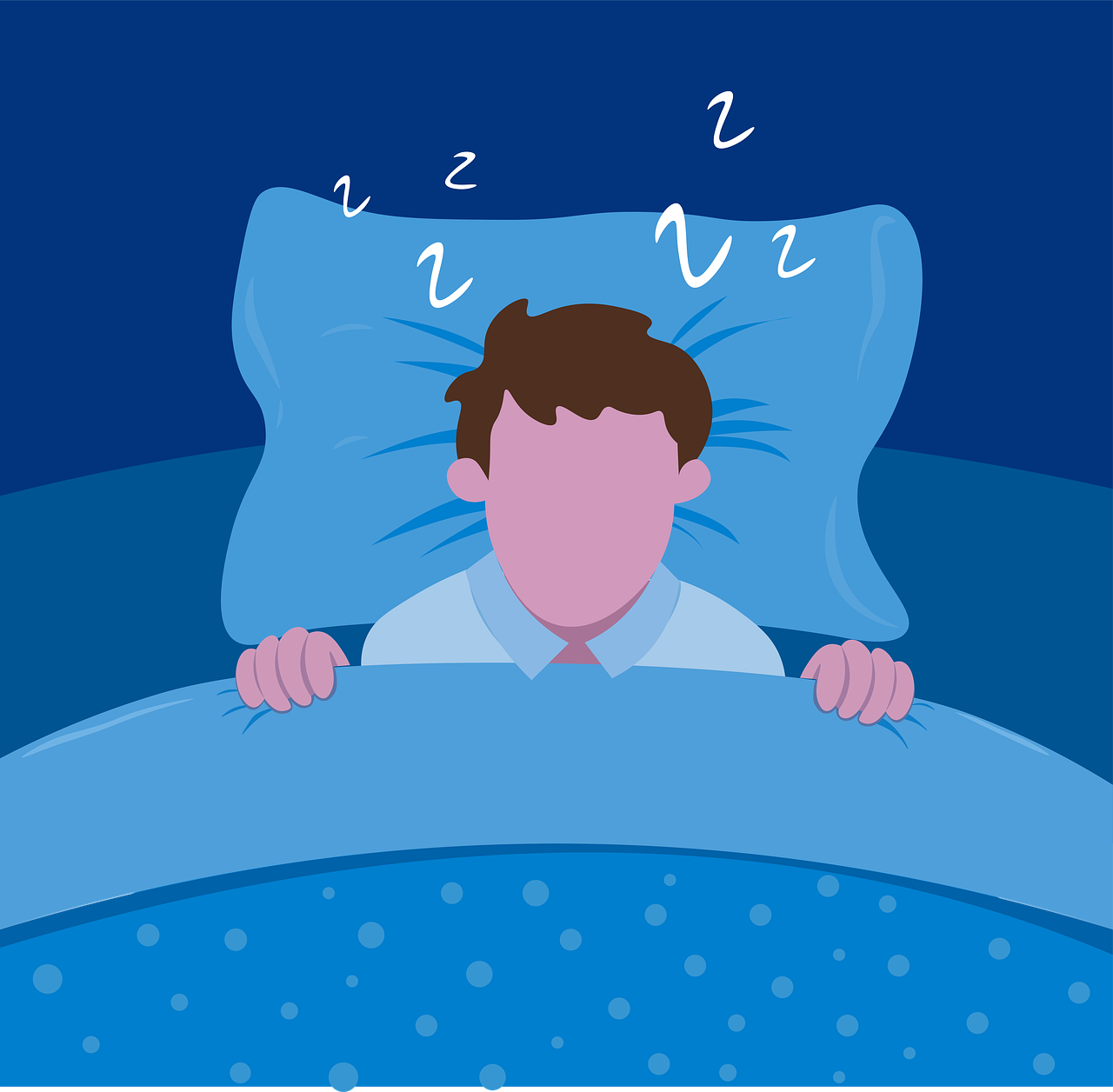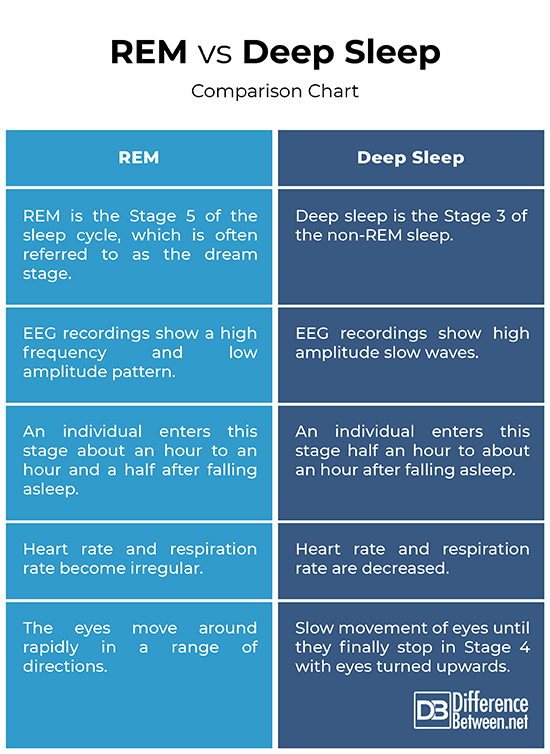Difference Between REM and Deep Sleep
We spend almost one-third of our lives sleeping. Well, researches and studies suggest that we need at least a seven good hours of nightly sleep to feel refreshed in the morning. A good healthy sleep is beneficial to both our body and mind. But our understanding of how sleep benefits us has advanced considerably over the years. A study of the sleep patterns in the 1950s by a University of Chicago physiologist, Nathaniel Kleitman led to a fascinating finding which suggested that sleep is not a state of coma, but rather a period of regular cyclic changes.
The normal sleep cycle consists of two stages: non-rapid eye movement (NREM) sleep and rapid eye movement (REM) sleep. Together, these two stages make one complete sleep cycle. The NREM sleep, also known as slow wave sleep (SWS) is a dreamless sleep stage which happens first and progresses in a fixed order as our body goes from light to deep sleep in four stages. REM sleep, often referred to as the fifth stage of a sleep cycle, is usually associated with dreams and is characterized by the rapid movement of the eyes. However, dreams can also occur in NREM sleep.

What is Deep Sleep?
During NREM, the electrical activity in the brain slows down and the brain waves change from rapid rate of waking to high-amplitude slow waves as the sleep deepens. The body seems to enter a state of hibernation as the physiological system tune down. The deep sleep is basically the Stage 3 of the NREM sleep cycle which is characterized by an EEG that displays high amplitude slow waves. Our body enters this stage after approximately half an hour to about an hour after falling asleep. It is followed by the Stage 4 of the NREM sleep, which is viewed as the deepest sleep stage in which the brain waves slow down significantly, indicating marked synchronization.
The physiological changes associated with deep sleep include decreased muscle tone, decreased heart rate and blood pressure, respiration slowing down, and lowered body metabolism. This is when our eyes and muscles start to relax as eyes begin slow, rolling movement until they stop with Stage 4 deep sleep with the eyes turned upwards. This stage is very important for our bodily function as the body starts to heal itself with the cells getting replaced, muscle tissues getting repaired, and immune systems becoming more active. There are usually no dreams in this stage. But about an hour and a half, the whole picture changes as our body enter the REM sleep stage.

What is Rapid Eye Movement (REM) Sleep?
REM, short for rapid eye movement, is often referred to as the Stage 5 of the sleep cycle, characterized by an EEG that shows a high frequency and low amplitude pattern, i.e. some desynchronized pattern seen in the waking state. Hence, the REM sleep is also called “fast wave sleep” or “desynchronized sleep” because our body’s system shift back into high gear, except for the major muscles that control movement. As the name suggests, the irises move around rapidly in a range of directions, producing the greatest number and reported intensity of dream reports. It is then, while our body goes into a temporary paralysis-like state, that the mind creates the hallucinations that we call dreams.
REM sleep is characterized by burst of conjugate eye movements, irregularities in respiration and heart rate, reduction of the muscle tone and twitching of limb muscles, particularly in the face, arms and legs. Middle ear muscles become active during REM sleep, as the body and the brain go through a plethora of changes. Further, it makes it more difficult to wake up from the REM sleep. However, if an individual wakes up from the REM sleep, he/she immediately starts to feel a sense of alertness and is aware of the environment.
Difference between REM and Deep Sleep
Sleep Stage in REM and Deep Sleep
– Deep sleep is the Stage 3 of the NREM sleep cycle which is characterized by an EEG that displays high amplitude slow waves. Subjectively, the human body enters this stage half an hour to about an hour after falling asleep and during this time, an individual is completely disengaged from the environment as the body goes into hibernation. REM is the Stage 5 of the sleep cycle which is characterized by an EEG that shows a high frequency and low amplitude pattern, and as the name suggests, the irises move around rapidly in a range of directions, representing a unique phase of sleep.
Physiological Changes in REM and Deep Sleep
– The physiological changes associated with deep sleep include decreased muscle tone, decreased heart rate and blood pressure, respiration slowing down, and lowered body metabolism. Unlike REM sleep, deep sleep is the time when the electrical activity around our brain slows down significantly. REM sleep is characterized by burst of conjugate eye movements, irregularities in respiration and heart rate, reduction of the muscle tone and twitching of limb muscles, particularly in the face, arms and legs.
REM vs. Deep Sleep: Comparison Chart

Summary
In nutshell, the deep sleep is the Stage 3 of the non-REM sleep cycle which is immediately followed by the Stage 4 of the NREM sleep, which is viewed as the deepest sleep stage in which the brain waves slow down significantly, leading to a progressive reduction in consciousness. This is when our eyes and muscles start to relax as the body starts to heal itself. The REM sleep, often referred to as the dream state, is immediately followed by the non-REM sleep and the individual is in the hard sleep state and is totally unresponsive to the environment.
- Difference Between Serif and Sans Serif - April 22, 2024
- Difference Between HTML and Text - April 19, 2024
- Difference Between FTP and SFTP - April 16, 2024
Search DifferenceBetween.net :
 Email This Post
: If you like this article or our site. Please spread the word. Share it with your friends/family.
Email This Post
: If you like this article or our site. Please spread the word. Share it with your friends/family.
1 Comment
Leave a Response
References :
[0]Mallick, Birendra N., et al. Rapid Eye Movement Sleep: Regulation and Function. Cambridge, United Kingdom: Cambridge University Press, 2011. Print
[1]Walker, Matthew. Why We Sleep: Unlocking the Power of Sleep and Dreams. New York, United States: Simon and Schuster, 2017. Print
[2]Cartwright, Rosalind D. The Twenty-four Hour Mind: The Role of Sleep and Dreaming in Our Emotional Lives. Oxford, United Kingdom: Oxford University Press, 2012. Print
[3]Hess, Dean, et al. Respiratory Care: Principles and Practice. Massachusetts, United States: Jones & Bartlett Learning, 2020. Print
[4]Khurana, Indu and Arushi Khurana. Medical Physiology for Undergraduate Students, 2nd Updated Edition. Gurgaon, India: Elsevier RELX India Pvt. Ltd.,2020. Ebook
[5]Image credit:https://www.publicdomainpictures.net/pictures/380000/nahled/schlafendes-madchen.jpg
[6]Image credit: https://cdn.pixabay.com/photo/2020/12/11/21/15/sleep-5823849_1280.png


What could happen if sleeping didn’d exceeds 2 to 3 hour’, what was the result would be like later in the future.